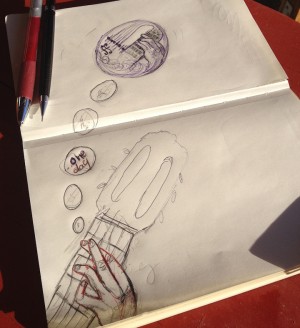A butterfly goes through stages: an egg, the first stage of a butterfly, hatches into a caterpillar. In this larval stage it goes through a series of mini-stages, continually shedding its skin until it finally sheds its last skin, revealing a chrysalis. The chrysalis stage provides a protective shell for it to metamorphose into its final stage: it bursts forth as a butterfly.
As human beings, growing up, we all go through developmental stages as we mature: from baby through child, adolescent, young adult, adult, and hopefully, on into even further stages of adult development.
The same sort of thing happens as you learn a technique: you go through stages.
The stages of technique development are perhaps not as clear cut as those of a butterfly, but it’s worthwhile to look at them and how they progress.
The Butterfly Barre
Let’s look at one technique, barring, from egg through butterfly.
Stage One: Egg
In stage one, your ability to barre is merely an idea, a wish, a desire that has only just begun to germinate by way of contact between your tender finger and the harsh realities of being unable to push it down hard enough across the entire fret to get that F-major barre chord to sound like more than a muffled, buzzy mess. All you have is a lot of frustration, sore fingers, and a clear, hopefully obtainable objective.
Stage Two: Caterpillar
In stage two, you try and you try and you try and you try. You ask yourself what’s happening, and what could happen. You try one thing, and then another thing. Your hand gives up when strength gives out, and your hopeful index finger allies with your wrist, thumb, hand, arm and body in different positions, different strategies, different angles, different ways of getting leverage. Each one can be seen as a new caterpillar crawling and developing until it sheds that skin for the next. E Each old skin you shed leaves behind a new hand-mind connection, a new bit of consolidated knowledge and integrated, balanced strength, that your hand and mind have both grown to encompass.
Stage Three: Chrysalis
Have you noticed that sometimes when you are sleeping, you dream about the things you are struggling with in your life? If that’s music, you dream about it? If it’s playing guitar, you dream about that? Metaphorically, and physically, the Chrysalis, a protective shell, gives the caterpillar’s cells a chance to dream themselves into an entirely new being. Similarly there’s an inner transformation going on every time you practice something and let it grow so you can then let it go. The inner work can be greatly helped along by “visualization,” or “imaging,” but it also happens subconsciously, protected deeply within the chrysalis of your mind’s workings. The key here is to trust that this will happen—because it will.
Stage Four: Butterfly
All of the work and play you’ve put into this, all the analysis and effort and intuition, all the skins you’ve grown and shed, have more than added up.
The clumsy, hopeful, ever-striving sequence of Caterpillar bars have completely restructured themselves into a new, full-fledged skill: the Butterfly Barre! You’ve tried every angle, felt into it from every position, let it learn and grow, and now, all of a sudden, you can let it go! It makes sense, it feels natural. It plays itself, without you having to think much about it any more— a whole new beast, discovering its wings and its feet, flowing, flying fluttering up and down the fingerboard and landing each time with a new, empowered sense of precision, strength and balance, appropriate to each chord.

